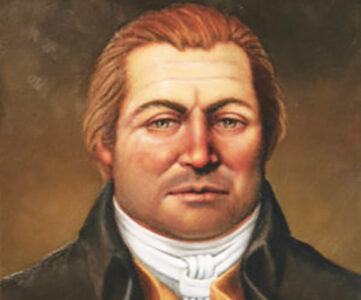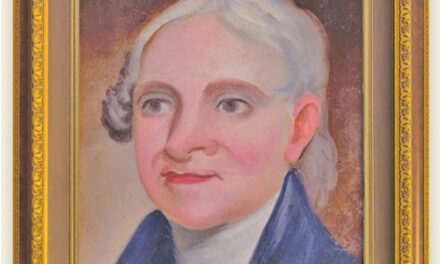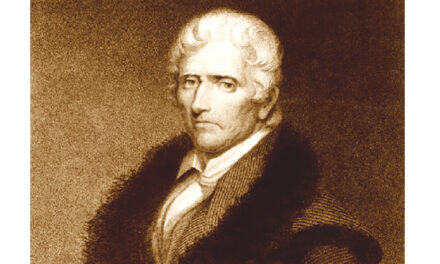
By David Streater
This vignette is an educational moment in American history. It is about those who made a difference during the Revolutionary War era and how they served our country.
Benjamin Cleveland, a rough-and-tumble guy, was born near Manassas, Virginia, on May 28, 1738. As a young man, Cleveland was a ruffian known for fighting, drinking to excess, gambling, and other indulgences. In his early 30s, Benjamin moved to Mulberry Fields, now Wilkesboro, North Carolina. There, Cleveland built a house near Daniel Boone’s home.
From his friendship with Daniel Boone, Cleveland learned about the frontier, including Kentucky. As an adventurer, Cleveland and his friends went on a frontier expedition in 1772. While exploring, they were ambushed, beaten, and robbed of their belongings and horses. After recovering, Cleveland assembled a posse and retrieved his horses and other property. This example of bravery sealed Cleveland’s status as a responsible mountain man.
The Lexington and Concord incursions led Cleveland to join the militia. Cleveland accepted a lieutenant’s commission in the Surry County, North Carolina Regiment Militia to stay close to home. His regiment marched to the Battle of Moore’s Creek Bridge. After this skirmish, Cleveland was promoted to captain.

Benjamin Cleveland
In the Fall of 1776, Cleveland was assigned to the North Carolina 2nd Battalion Militia. Their objective was to block potential British aggression along the coasts of North and South Carolina. In December 1777, the North Carolina legislature officially created Wilkes County. Cleveland was appointed the Wilkes Regiment of Militia Commandant as a colonel.
Cleveland and his militiamen showed no mercy for captured prisoners of war. Cleveland and his troops became known as the “Cleveland Bulldogs.” Their practices included hangings, mutilations, and burnings. The British troops called them the “Cleveland Devils.”
Other violent actions by the Devils included beatings and “hanging Tories by their thumbs until they confessed to British movements.” This is how the adage “hanging one by his thumbs” began. These exploits convinced many Tories to switch sides and join the American patriots’ cause for independence.
Using his draconian leadership style, Cleveland had some hoodlums and Tories tortured and hanged. For this, Cleveland was indicted for murder by the Superior Court of Salisbury, North Carolina. Then, on November 6, 1779, the Governor of North Carolina pardoned him.
In 1780, the British, led by Ferguson, started a movement to attack the Carolinas at Kings Mountain. Tories and other loyalists joined the Redcoats. When their assault plan was learned, Cleveland and the Overmountain Men prepared to confront them. Cleveland and others assembled at Quaker Meadows, Morganton, NC (a few miles from Foundation Forward’s national office) in early 1780. At this meeting, those in attendance planned the Battle of Kings Mountain. “Among all the desperate fighters there engaged, not one showed more personal courage than Col. Benjamin Cleveland.”
The bloody and gruesome Battle of Kings Mountain fought on October 7, 1780, carved Cleveland’s name in history. The Patriots and Tories volleyed in direct combat. Eventually, Cleveland and his men tasted victory.
Cleveland returned home after the Kings Mountain war tribunal of Tories and vandals. Due to loopholes in the North Carolina law, Cleveland lost his home to unprincipled opportunists while he was deployed. In 1784, he moved to South Carolina and served as a judge in the Pendleton District.
Overweight, Cleveland remained a judge until his death (while eating breakfast) on October 15, 1806. Cleveland’s military practices earned him the nickname “Terror of the Tories.” Monuments and historical markers recognize Benjamin Cleveland for his war efforts. Counties in North Carolina and Tennessee are named for him, along with the Cleveland Chapter of the Daughters of the American Revolution.
Please visit your Charters of Freedom setting at the Conover City Park, Conover, NC, Education Park, Valdese, NC, and the Historic Courthouse, Morganton, NC. A Charters of Freedom setting consists of the Declaration of Independence, the United States Constitution, the Bill of Rights, and the Civil Rights Amendments. Settings are on permanent display akin to the Charters of Freedom in the National Archives, Washington, DC. Visit our website (FoundationForward.com) to learn more about our settings. Vance and Mary Jo Patterson are the benefactors of Foundation Forward, a 501(c)(3) education non-profit that makes all Charter of Freedom settings possible.
Teachers may contact Dr. David Streater, education director ([email protected]), for information and complementary student education materials to enhance experiential field trips to Charter of Freedom settings.









